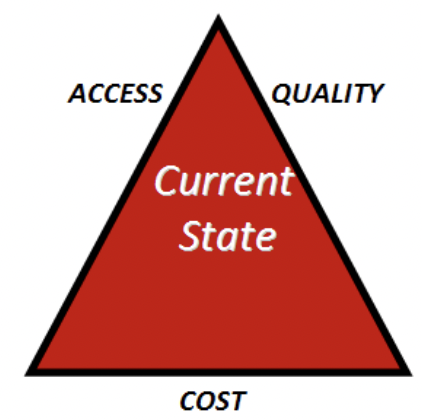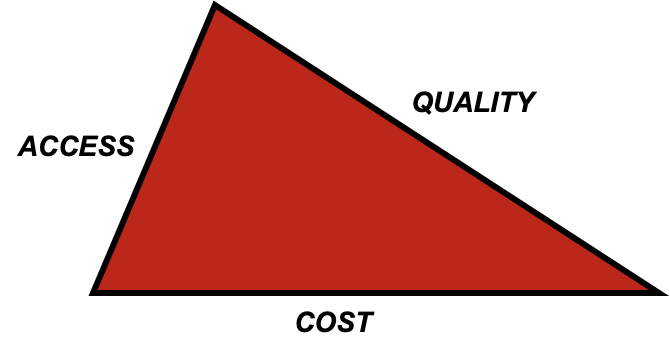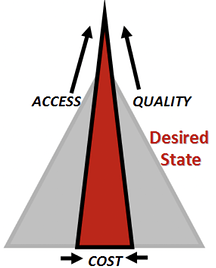The Elastic Triangle
My views on quality in education are shaped by hearing Sir John Daniel’s speak in Vancouver back in 2009-20210 timeframe on the Iron Triangle (Daniel, Kanwar, & Uvalic-Trumbic, 2009).
THE IRON TRIANGLE MODEL

The origin of this model is that ministers of education seek to provide wide access to high-quality education at a low cost. A goal I think we all share.
The Iron Triangle Model diagram shows current state of provision, with Quality, Access and Cost the three key elements existing in relationship to each other as sides of a triangle.
Strategically there are two characteristics to the Iron Triangle:
- The triangle is modifiable. You can lengthen or shorten sides of the triangle and see how doing so affects the other sides.
- The triangle has a fixed-length perimeter. You cannot increase Quality without affecting Access and / or Cost. Changing the length of any one side involves trade-offs with the other sides.
For example, attempts to increase Access may increase Cost and / or reduce Quality.
Or attempts to increase Quality may reduce Access and increase Cost.
The fixed length characteristic of the Iron Triangle suggests there is a zero-sum relationship between Quality, Access, and Cost, hence the term “iron.”
The Iron Triangle was first conceived as a way of modeling traditional classroom based education. Back in 2009-2010, at the time when I first heard Sir John speak about the Iron Triangle, online learning was burgeoning. Daniels, and others (see sample of references at end of this post), did a good job of exploring how online learning could affect the Iron Triangle noting the use of technology allows for improvements in accessibility and quality, as well as economies of scale that classroom education simply cannot attain.
THE ELASTIC TRIANGLE MODEL
In the ensuing years it has become clear that online learning, done well, can render the iron triangle flexible. But while online learning gives the triangle some flexibility it is not until you add in the concept of open education that the triangle becomes truly elastic.
Here’s how.
The central challenge of the iron triangle is to simultaneously widen education access, make quality higher, and lower cost. This desired state looks like this:
One of the most fascinating aspects of the Iron Triangle Model is how Access, Cost, and Quality are defined. Access and Cost are defined quantitatively.
Access = number of students
Cost = per capita costs of education
But what about quality? Quality is more amorphous than access and cost, harder to define in a quantifiable way. A large part of the presentation and description of the Iron Triangle model explores what is meant by “Quality”.
Historically a characteristic of education has been that it is difficult to get into. Here quality is defined as exclusivity. Only those with high marks or other predetermined desirable characteristics (including ability to pay for tuition) are accepted.
Another dimension of quality associated with the place-based classroom lecture model of education is expenditure per student. Here the assumption is that the higher the expenditure on facilities and teachers the better the quality.
A belief that these constitute quality leads to a perception that an institution with tough admission requirements and high fees is a good institution, regardless of what happens within its walls.
Class size, ratio of number of teachers to number of students, and associated extent of teacher student interaction is also used as a proxy for quality with the argument being more students means less teacher student interaction and therefore lower quality unless the cost is increased by hiring more teachers.
More recently the emphasis has shifted to outcomes and examinations of student achievement as measured by standardized tests. Here quality is defined as student success in achieving learning outcomes.
But success in achieving learning outcomes is still predicated on support of some kind. As we move away from place-based learning into online learning three interactions and supports are seen as crucial to student success – student interactions with content; student interactions with other students; and student interactions with teacher.
While some studies show student-content interaction has the greatest effect, studies also show that self-paced independent study without student to student and / or student to teacher interaction leads to higher dropout and incompletion rates. Clearly each type of interaction is important and contributes to student performance. In the online learning context quality entails student interactions with high quality content, high quality student to student interactions, and high quality student to teacher interactions.
Breaking Higher Education’s Iron Triangle: Access, Cost, and Quality concludes:
“The aims of wide access, high quality, and low cost are not achievable, even in principle, with traditional models of higher education based on classroom teaching in campus communities. A perception of quality based on exclusivity of access and high expenditure per student is the precise opposite of what is required. One based instead on student achievement enables developing countries to scale up their higher education age participation rates without breaking the bank or fatally compromising quality.”
While online learning makes the Iron Triangle somewhat more flexible I assert that only open education converts the Iron Triangle into an Elastic Triangle.
Let’s start with Cost. The Iron Triangle quantifies Cost as cost of education per capita. This presumes the costs of education are self-contained within a nation, state or region. An essential aspect of open education is the open licensing of teaching and learning resources to be shared with others. This sharing is not constrained by the boundaries of a country but rather is openly shared with everyone around the world. This global sharing converts Cost from a country per capita basis to a global per capita basis. This is a huge change as it means all countries, including developing countries, have access to a large and ever-growing pool of educational resources at no cost. Costs each country has traditionally borne on its own for creating education are now shared and readily available existing materials reduces the current wide scale practice of redundant and repeated development of courses over and over again.
The digital nature of most open educational resources also helps transform the Cost vector from iron to elastic. The costs associated with copying, distributing, and storing digital education resources are close to zero. However, only the unique licenses of open education give everyone the right to freely copy, distribute, retain and modify digital resources. Open education frees education from being fettered and proprietary.
The cost vector can be chunked into costs associated with student interactions with content; student interactions with other students; and student interactions with teacher. In this context it’s important to note that open education is not just about openly sharing resources it also entails open pedagogies which engage students in co-creating content and in doing assignments that contribute to solving global social issues such as the Sustainable Development Goals or contributing to digital public goods such as Wikipedia. Open pedagogies not only make the cost of education elastic but contribute to reducing costs associated with global well-being.
Let’s turn now to Access. The Iron Triangle defines Access as number of students. In the traditional model this is largely defined as enrolments in place-based schools and institutions of higher education. Online learning made the Access vector somewhat more elastic by showing number of students need not be tied to a particular place or facility. Open education is increasing that elasticity even more. Open educational resources are openly shared with everyone. Their use is not constrained to formal academic settings. Open education resources are public goods accessible and available to everyone, even those not formally enrolled as “students”.
In addition to being freely shared open educational resources can be revised and remixed. They can be translated, modified, customized, and adapted to local contexts and needs. This ability to modify and adapt open educational resources ensures they are even more accessible by empowering customization of education to maximize relevance and inclusion. Open education increases access by more accurately ensuring education represents location, culture and identity.
Finally lets turn to Quality. In open education, quality is made more elastic by making it a community driven process. Rather than relying on the subject matter expertise of a single author, open educational resources are typically authored in collaborative teams drawing on a broader cross section of expertise.
The open sharing of open education content, practices and pedagogies ensures they are in essence peer and community reviewed. In open source software development there is a similar practice. Linus’s law is the assertion that “given enough eyeballs, all bugs are shallow”. The law equally applies to open education. Open education quality is derived by making education transparently visible to all in such a way that others have the agency to use them and errors and improvements can be identified and made by all.
Once education is made “open” the very practice of education can qualitatively improve. The emergence of open education practices and pedagogies particularly around engaging students as active co-creators of knowledge is a unique attribute of open education. Having learners engage in assignments that address real needs of society through the development and sharing of digital public goods dramatically increases student engagement and motivation. It is worth asking whether student contributions to fulfilling social needs and making the world a better place are higher quality evidence of achievement of learning outcomes than those typically assessed in exams and tests. Open education uniquely converts the education process from that of being a passive recipient of education as a service to one in which you are an active participant creating and sharing knowledge in ways beneficial to all.
Stretching Your Thinking
I hope this post has stretched your thinking. I think the Iron Triangle provides an interesting interactive mental model for envisioning different ways we can provide wide access to high-quality education at a low cost.
Thanks for joining me on this thought experiment and hearing me out on my assertion that open education uniquely transforms the Iron Triangle into an Elastic Triangle.
I hope you will join me in discussing this. Questions, ideas, thoughts and suggestions are welcome. Simply click Reply to this post.
References
Daniel, J., “Education across space and time”, (2013)
Daniel, J. “Making Sense of Flexibility as A Defining Element of Online Learning”, (2016)
Daniel, S. J., Kanwar, A., & Uvalic-Trumbic, S. (2009). Breaking higher education’s iron triangle: Access, Cost, and Quality. Change, March-April
Power, M. & Gould-Morven, A. (2011). Head of Gold, Feet of Clay: The Online
Learning Paradox. International Review of Research in Open and Distributed
Learning, 12(2), 19–39.
Raymond, E. S., The Cathedral and the Bazaar, (1999)

